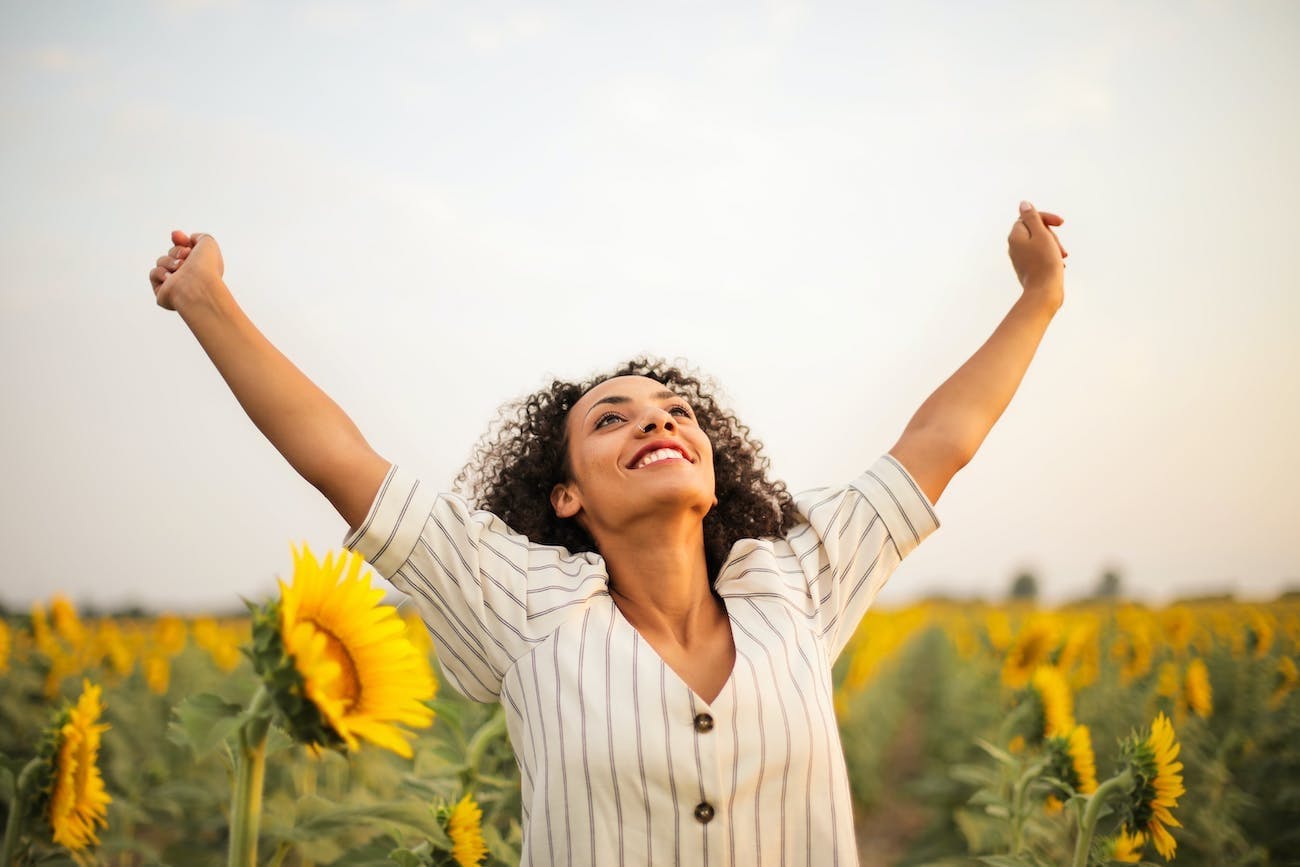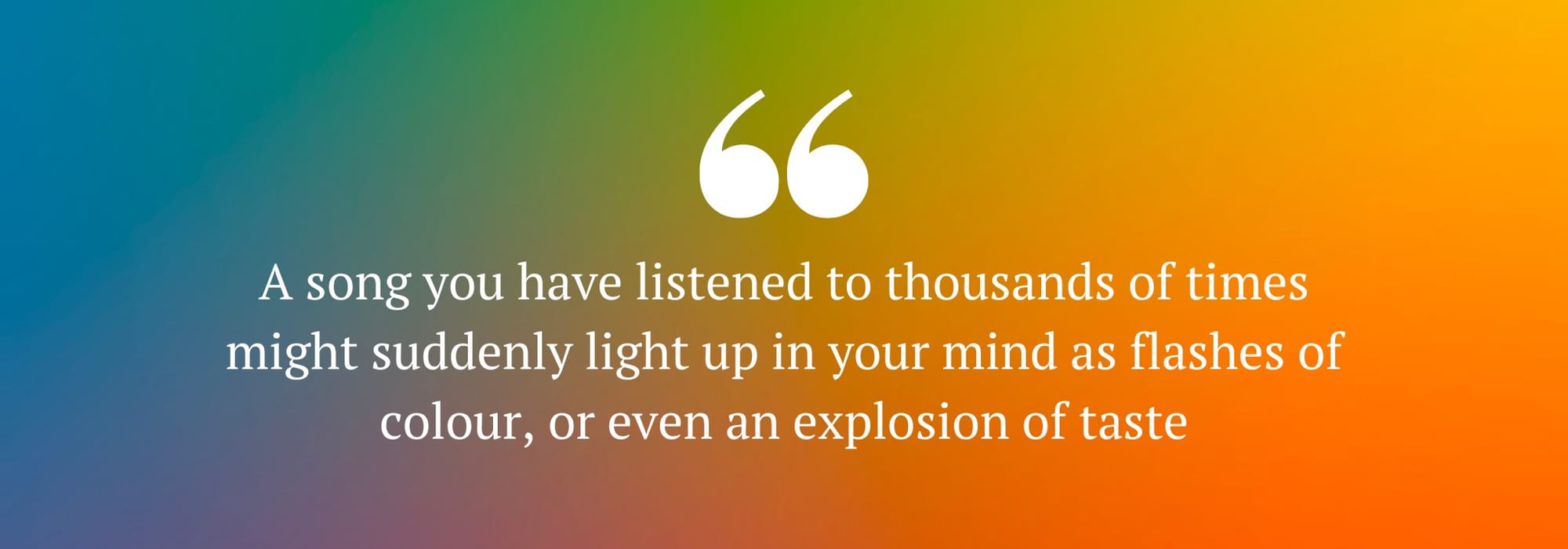How to live a multi-sensory life (and why you should try it)
updated on Feb 26, 2024

Synaesthesia – experiencing one sense through another, like ‘seeing’ smells – is a rare condition, but we could all enjoy the benefits of heightened awareness
It was as she went through menopause that Paula Sandham Burns experienced a sensory explosion. She suddenly noticed a heightened sense of smell, or hyperosmia.
“For most people, this is just unpleasant, but for me, it was the opposite,” she says. “It immersed me in a world of wonderful 3D shapes, colours, movement, personality, and profound emotion.”
Paula started seeing smells as shapes in the air. She explains: “I knew they were the smells. I knew in my mind that was what they looked like, although I hadn’t seen them physically around me like that before.” She then spent years researching what was happening in her mind, and why.
She discovered she is among the estimated 4.4% of the world population with synaesthesia. This rare, inherited condition causes a merging of the senses. The Synesthesia Tree website, which Paula runs, lists more than 100 types of synaesthesia, but most common are experiencing days and months in colour, or ‘seeing’ or having a feeling of a colour for letters and numbers.
Synaesthetes might also experience tastes as colourful moving shapes in their line of vision, feel colours as sensations against the skin, or perceive sounds as odours or flavours, according to the Multisense team at the University of Sussex.
This group is studying the condition and, using psychology and cognitive neuroscience, has been documenting experiences. Professors Julia Simner and Jamie Ward have written about people in whom spoken words produce taste, and people who experience touch just by looking at someone else being touched.
Dr Simner, who is co-editor of The Oxford Handbook of Synaesthesia, describes it as “a more extreme manifestation of what all of us experience”.
For Paula, there was a huge sense of relief when she finally unravelled and linked her experiences. “Everything finally clicked. I gradually realised all the other types [of synaesthesia] that I had, and in a period of about two weeks the floodgates just opened.”

What followed was a fortnight in which Paula embraced her multi-sensory experiences, and began to live in “an altered state”. She explains: “I’ve adjusted my reality to it since then, and I feel much happier, more complete. It’s the best thing that ever happened to me.”
Paula argues that everyone could learn little ways to enjoy their senses more, and perhaps even discover capabilities that they didn’t realise they had. Being a synaesthete has had a profound impact on her abilities to retain and recall memories, for example, because her multi-sensory experiences have a bigger emotional impact on her.
She says: “I might remember the shapes, movement and emotions a new food gave me when I tried it, plus all the background information - like where exactly I was sitting and who I was with.” Multi-sensory experiences have depth and power.
This has been the experience of former teacher Nicole Bateman, and occupational therapist Kate Smith. Together they run the Super Sensory Squad, an organisation, which helps young people understand their sense systems. They argue that being aware of all of our eight senses – sight, taste, touch, hearing, smell, balance, movement, and interoceptive (internal) – has a huge impact in their field, changing how teachers teach.
Nicole says: “To take one example, now that I understand more about the importance of proprioception [muscle feedback] for regulation for some individuals, if I observed some rough play or someone squeezing their friend too tightly, I would be asking in my head, ‘Are they seeking that proprioceptive input, and how can I give them that input in a productive way in the classroom?’ This might be a weighted lap pad or exercise bands on their chair legs, to allow them to ‘feel’ while they are watching and listening.”
Nicole explains that this changes students’ levels of concentration. She says: “Building our awareness of our senses – and how they all interact with each other – improves emotional regulation, which enables us to access high cognitive functions, such as memory and language processing.”
The team at Sussex University is investigating how the human brain comes to develop this complex condition. There have been nods to the possibility that we are all born as synaesthetes, but the majority of us lose these “cross modal associations” before we are able to vocalise the experience. This remains debated.
However, we can all work to hone our awareness of our senses, not least because it could be fun, argues Paula.
She says: “I can put on my headphones and ‘watch’ music when I want, as if every song had its own abstract video in virtual reality. As I have auditory-tactile synaesthesia too, I can feel the music through my hands or feet, or each instrument somewhere different on my face or body, at the same time.”

She encourages everyone to try: “We can all do exercises like listening to music with good headphones in the dark, and concentrating on how we perceive it with all our senses. Thinking about what the direction, movement, shape, colour, smell, or taste of the music might be is always a great idea, as it opens up our mind to the structure of the music.” A song you have listened to thousands of times might suddenly light up in your mind as flashes of colour, or even an explosion of taste.
As Paula says simply: “It’s like having a B-side to your universe, where things are even more beautiful.”
Acknowledge and respect how your body feels
Growing up, we may have heard phrases at school like ‘That doesn’t hurt’ when, actually, it did. This impacts our awareness of how our body feels, and brings feelings of embarrassment and shame. No matter how your body feels, acknowledge and respect it, to then follow on with actions to make it feel better. We all have different inner experiences, and it is important we acknowledge that we experience the world uniquely.
Commit to trying a variety of activities, and try something new regularly
We need a range of ‘feel good’ activities we can draw on to help self-regulation. Try different activities, with different sensory inputs, to find what makes you feel the best. Pilates and mindfulness are great for developing an awareness of, and listening to, your body. Integrate these into a sensory lifestyle to promote your regulation and mental health.
Recognise which body signals are linked to which emotions
Our sensory needs can change depending on many factors, including our levels of anxiety, mood, having to face a traumatic history, or behavioural challenges. It’s important to recognise what signs of sensory dysregulation you have, e.g. clenching your jaw, moving around more, being more sensitive to smells etc. This will help you recognise an emotional change within you, that you need to address.

